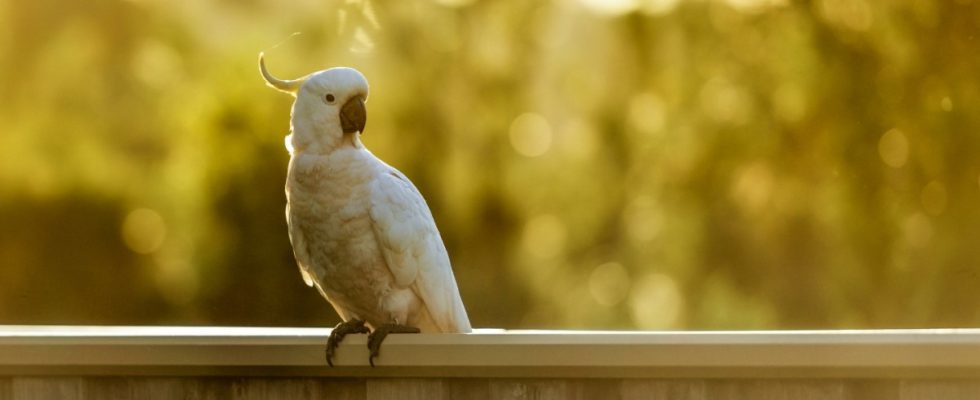When it comes to food, goff cockatoos are very inventive: They make tools to get food that they can’t reach with their beaks. In the lab, they pull, push or turn all kinds of closures to open boxes containing delicious cashews. And if necessary, they even use their beak as a screwdriver and simply unscrew the screws from the lid to open it.
Jeroen Zewald and Alice Auersperg from the Messerli Research Institute at the University of Veterinary Medicine in Vienna were able to observe that the snow-white birds, which are approximately 30 centimeters tall, have another amazing ability: “The cockatoos prepare their food to improve their eating experience,” says Alice Auersperg. To be more precise, they dip rusks in water so that they become soft and easier to eat. Similar to a person dipping a hard biscotto into their cappuccino. Such behavior is very rare in animals, the researchers write in their study, which appears in the scientific journal Biology Letters has appeared.
Preparing food is a sign of intelligence
Auersperg and Zewald discovered this previously unknown ability of the goff cockatoos, which occur in the wild on some Indonesian islands, by chance. While feeding the birds, they observed one of the cockatoos named Pipin dipping a piece of rusk into the water bowl in which the animals usually bathe. After a while Pipin fished out the rusks again and ate them. A short time later, the researchers noticed that Kiwi and Muki, two other birds from the group, also watered their rusks before eating.
In order to get to the bottom of the cockatoos’ strange behavior, Zewald observed the birds’ behavior during lunch, which is served to them promptly at 2 p.m. every day, for twelve days. So he found out that not only Pipin, Kiwi, and Muki were dipping their food into the water, but also four other cockatoos from the group in which 18 birds live together.
The researchers conclude from various observations that the birds dip the rusks into the water to make them more digestible. For one thing, the birds ate almost exclusively rusks, although their lunch also includes seeds, dried fruits, dried vegetables and other ingredients. “In addition, cockatoos that were fed alone and did not have to worry about another bird snatching the rusks from them waited for several seconds before they took the rusks out again,” says Auersperg. Some even turned the rusks over after a while – as if they wanted to make sure that they were soaked evenly on both sides. “We don’t know whether that’s really the intention,” says Auersperg, but “to wait so long and go to such lengths is quite remarkable.”
The white parrots are unsuitable as pets – they need to be kept busy all the time
In general, there seemed to be little effort too much for the cockatoos to give the rusks their delicious, mushy texture. Even if the food bowl was on the floor of the aviary and the water reservoir was on the ceiling, they flew all the way with the rusks in their beaks. “Sometimes the piece would fall down, then they would pick it up and transport it up again,” says Auersperg.
As astonishing as it is that Goffin cockatoos have not yet invented cooking, but have invented something like a preliminary stage of it, anyone like Auersperg and Zewald who has to deal with these highly intelligent birds on a daily basis is probably no longer surprised by anything.
It has long been known that parrots use entire sets of tools and can make them themselves. “For example, wild goff cockatoos in Indonesia use a ‘wedge’, a ‘knife’ and a ‘spoon’ to get to hard-to-reach pulp,” says Auersperg. They open the fruit with the wedge, cut it with the knife and finally take out the pulp with the spoon.
Because of their high intelligence, coupled with an irrepressible urge to move, it is practically impossible to keep goff cockatoos as pets in a species-appropriate manner. “A goff cockatoo is like a three-year-old child who you play with a lot, who you have to cook for three times a day and who doesn’t grow up for 40 years,” says Auersperg.
In Vienna, a whole team is busy looking after the animals. Cooking takes turns; for breakfast there is, among other things, cauliflower, a pasta mix and potatoes: the birds have to be able to choose so that they have a good time. The white parrots have a sandpit, a suspension bridge and a carousel, but that’s not enough, someone always has to come up with a new toy. “The cockatoos also want to be challenged cognitively,” says Auersperg. Whenever a study comes up for which they can show how they make tools or opening complicated locked boxesthe birds are happy and join in enthusiastically.

